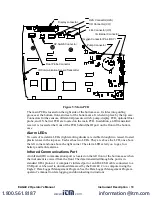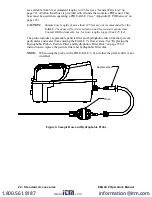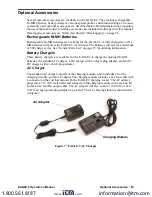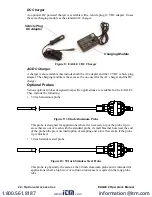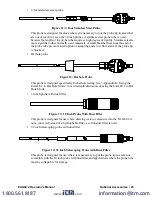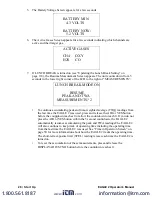
16 • Instrument Description
EAGLE 2 Operator’s Manual
Case
The EAGLE 2’s sturdy, high-impact plastic case is radio frequency (RF) resistant and is
suitable for use in many environmental conditions, indoors and out. The case is dust proof
and water resistant. It’s two main components, the top case and bottom case, are held
together with three screws located on the bottom case. The interface between the top case
and bottom case is gasketed. A sturdy, well balanced handle on the top case allows you to
hold the instrument comfortably. A clear plastic window is located on the top case to the
front of the handle for viewing the LCD.
A removable battery case is located at the rear of the bottom case. A thumbscrew secures
the battery case to the bottom case. The interface between the battery case and the bottom
case is gasketed. Six raised feet on the bottom of the case, four on the bottom case and two
on the battery compartment, raise the EAGLE 2 slightly from the surface on which it rests.
Sensors
The EAGLE 2 uses up to six sensors to monitor combustible gas, oxygen (O
2
), carbon
monoxide (CO), hydrogen sulfide (H
2
S), and various other toxic gases simultaneously.
The sensors are located inside the EAGLE 2 bottom case and are installed in the flow
chamber. The sensors described below are the four standard sensors. See “Appendix D:
PID Sensors” for a description of the PID sensors, “Appendix E: ESM-01 Toxic Sensors”
for a description of the ESM-01 toxic sensors, “Appendix F: TC Sensors” for a description
of the TC sensors, “Appendix G: Infrared Carbon Dioxide Sensors” for a description of
the IR CO
2
sensors, “Appendix H: Infrared Methane Sensor” for a description of the IR
methane sensors, and “Appendix I: Infrared Hydrocarbon Sensor” for a description of the
IR hydrocarbon sensor. The standard sensors use different detection principles as
described below.
Catalytic Combustible Gas Sensor (LEL Sensor)
The catalytic combustible gas (LEL) sensor detects combustible gas in the %LEL range. It
uses a catalytic element for detection. The reaction of gas with oxygen on the catalyst
causes a change in the resistance of the element which changes the current flowing
through it. The current is amplified by the EAGLE 2’s circuitry, converted to a
measurement of combustible gas concentration, and displayed on the LCD.
The LEL sensor housing includes a sintered metal flame arrestor on one end that allows
gas to diffuse into the sensor. On the other end, five pins extend from the sensor. The
sensor cable connects to these pins on one end and terminates in a four-position connector
on the other end which plugs into the
HC
socket on the main PCB (see “Main PCB” on
Oxygen Sensor
The O
2
sensor is a galvanic type of sensor. A membrane behind the openings on the sensor
face allows gas to diffuse into the sensor at a rate proportional to the partial pressure of
oxygen. The oxygen reacts in the sensor and produces a voltage proportional to the
concentration of oxygen. The voltage is measured by the EAGLE 2’s circuitry, converted
to a measurement of gas concentration, and displayed on the LCD.
The sensor includes a short cable that terminates in a round 7-position connector. It mates
with the
OXY
pins on the main PCB (see “Main PCB” on page 19).
www.
.com
information@itm.com
1.800.561.8187


















